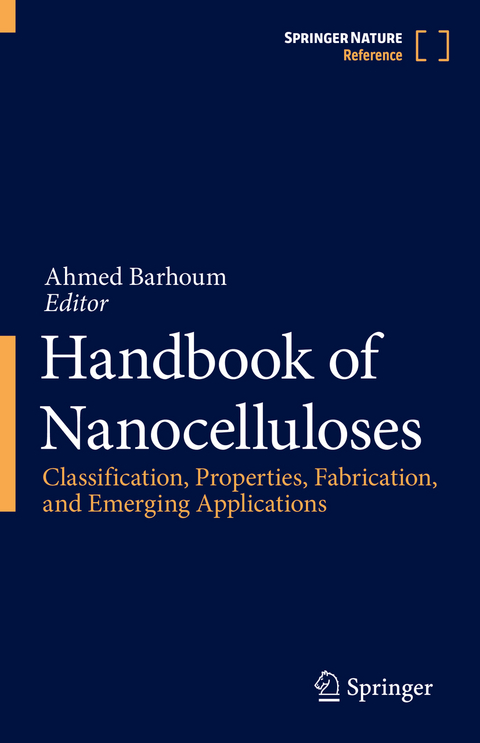
Handbook of Nanocelluloses
Springer International Publishing (Verlag)
978-3-030-89620-1 (ISBN)
This Handbook covers the fundamental aspects, experimental setup, synthesis, properties, and characterization of different nanocelluloses. It also explores the technology challenges of nanocelluloses and the emerging applications and the global markets of nanocelluloses-based systems. In particular, this book:
· Covers the history of nanocelluloses, types and classifications, fabrication techniques, critical processing parameters, physical and chemical properties, surface functionalization, and other treatments to allow practical applications.
· Covers all recent aspects of nanocelluloses technologies, from experimental set-up to industrial applications.
· Includes new physical, chemical and biological techniques for nanocelluloses fabrication, in-depth treatment of their surface functionalization, and characterization.· Discusses the unique properties of nanocelluloses that can be obtained by modifying their diameter, morphology, composition and dispersion in other materials.
· Discusses the properties and morphology of several kinds of dispersion in polymeric materials, such as micro/nanofiberlated cellulose, cellulose nanofibers, cellulose nanocrystals, amorphous cellulose nanoparticles, and hybrid cellulose nanomaterials.
· Presents the different techniques for dispersion, and self-assembly of polymeric materials, critical parameters of synthesis, modelling and simulation, and characterization methods.
· Highlights a wide range of emerging applications of nanocelluloses, e.g. drug delivery, tissue engineering, medical implants, medical diagnostics and therapy, biosensors, catalysis, energy harvesting, energy storage, water/waste treatment, papermaking, textiles, construction industry, automotive, aerospace and many more.
· Provides an outlook on the opportunities and challenges for the fabrication and manufacturing of nanocelluloses in industry.
· Provides an in-depth look at the nature of nanocelluloses in terms of their applicability for industrial uses.
· Provides in-depth insight and review on most recent types of nanocelluloses-based systems of unique structures and compositions.
· Highlights the challenges and interdisciplinary perspective of nanocelluloses-based systems in science, biology, engineering, medicine, and technology, incorporating both fundamentals and applications.
- Demonstrates how cutting-edge developments in nanofibers translate into real-world innovations in a range of industry sectors.
This Handbook isa valuable reference for materials scientists, biologists, physicians, chemical, biomedical, manufacturing and mechanical engineers working in R&D industry and academia, who want to learn more about how nanocelluloses-based systems are commercially applied.
lt;p>Dr. Ahmed Barhoum is a Researcher at Institut Européen des Membranes, Université de Montpellier and tenured Lecturer of Nanotechnology at the Chemistry Department of Helwan University. He obtained his Ph.D. and Postdoc-fellow in Chemical Engineering from Vrije Universiteit Brussel and he was also previously a researcher at Grenoble Institute of Technology (France, 2012), Leibniz Universität Hannover (Germany, 2015), and Institut du Europeen Membrane (France, 2016), Université de Montpellier (France, 2018). His current research focus on the synthesis of nanoparticles, nanofibers, and thin films for applications in the fields of energy production, wastewater treatment, electrochemical biosensors, and drug delivery. Dr. Barhoum has won several scientific grants and prizes for his academic excellence: Chinese Academy of Science (China, 2019), Institut français d'Égypte (France, 2018), Research Foundation Flanders (Belgium, 2016), Research Foundation Flanders (Belgium, 2015), Medastar Erasmus Mundus (Belgium, 2012), Welcome Erasmus Mundus (Italy, 2012), Institut français d'Égypte and Campus France (France, 2012), Gold Medal from Egyptian Syndicate of Scientific Professions (2007), Gold Medal from Helwan University (2007), among others. He is an expert evaluator for several funding organizations e.g. National Science Center (Poland), Czech Science Foundation (Russia), Swiss National Science Foundation (SNSF, Switzerland), and a reviewer for +20 peer-reviewed journals including American Chemical Society, Elsevier, Wiley, and Springer Nature.
Fundamentals.- Nanofabrication.- Processing.- Energy and Electronics.- Biomedical Applications.- Enviromental Applications.- Constructions and other Applications.
| Erscheinungsdatum | 17.07.2022 |
|---|---|
| Reihe/Serie | Handbook of Nanocelluloses |
| Zusatzinfo | XX, 1081 p. 280 illus., 230 illus. in color. |
| Verlagsort | Cham |
| Sprache | englisch |
| Maße | 155 x 235 mm |
| Gewicht | 1996 g |
| Themenwelt | Naturwissenschaften ► Biologie ► Biochemie |
| Naturwissenschaften ► Chemie ► Organische Chemie | |
| Naturwissenschaften ► Physik / Astronomie ► Atom- / Kern- / Molekularphysik | |
| Naturwissenschaften ► Physik / Astronomie ► Festkörperphysik | |
| Technik ► Maschinenbau | |
| Schlagworte | Biomedical Applications • Cellulose Nanomaterials • nanocelluloses • nanofibers-based systems • Nanomaterial • Tissue engineering |
| ISBN-10 | 3-030-89620-X / 303089620X |
| ISBN-13 | 978-3-030-89620-1 / 9783030896201 |
| Zustand | Neuware |
| Haben Sie eine Frage zum Produkt? |
aus dem Bereich


